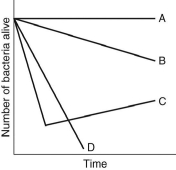Scenario
Different species of bacteria are resistant to different types of antibiotics. For example, one species of bacteria may be resistant to an antibiotic that targets bacterial ribosomes but may not be resistant to a different antibiotic that targets bacterial cell walls. In order to figure out what type of antibiotic(s) a species of bacteria was resistant to, a researcher treated the bacteria with four different antibiotics (A, B, C, and D) and measured how many bacteria were alive over the course of a few weeks. The data that she collected are summarized below. 
-Why do bacteria numbers start to decline when treated with antibiotic C but then begin to increase as time goes on?
A) Some bacteria with resistance to antibiotic C were selected for over time.
B) Additional bacteria were added to the experimental group.
C) Antibiotic C degraded and thus was no longer effective.
D) This is the normal course of bacterial growth no matter which antibiotic is applied.
Correct Answer:
Verified
Q40: Similar to the nucleus, chloroplasts and mitochondria
Q41: Scenario
Different species of bacteria are resistant to
Q42: Scenario
The first prokaryotic cells gave
Q43: The child shown in the figure below
Q44: The microscope best for viewing living cells
Q46: The figure shows a Paramecium, a single-celled
Q47: Where is this molecule normally found in
Q48: You are working in the lab and
Q49: Scenario
Different species of bacteria are resistant to
Q50: Tobacco smokers (and those exposed to tobacco
Unlock this Answer For Free Now!
View this answer and more for free by performing one of the following actions

Scan the QR code to install the App and get 2 free unlocks

Unlock quizzes for free by uploading documents